3D drafting and 3D rendering are two important computer-aided design techniques. They are used for creating and visualizing three-dimensional objects. 3D drafting requires the use of specialized software tools to create detailed technical 3D object drawings.
3D rendering, on the other hand, uses computer software to create photorealistic images of 3D models. Both techniques are mainly used in the architectural and interior designing industry. In this article, we will learn about what is 3D drafting and five effective ways to increase your productivity at 3D drafting.
An Introduction to 3D Drafting
In 3D drafting, designers use specialized software programs to create three-dimensional models of objects. These models can be viewed from different angles. They can be rotated and manipulated to provide a comprehensive view of the object’s structure and design. They are rendered to create photo-realistic images or animations. These can be used for presentations, marketing, or promotional materials.
How to Create Accurate 3D Designs in Less Time?
Creating a good 3D design comes with its own set of challenges. It is much more than using good software. 3D designing as a process requires:
- Attention To Detail: It involves precisely and accurately representing an object or space. You need to have a keen eye for detail and the ability to spot errors or inconsistencies.
- Creativity: While 3D drafting requires technical skills, it also requires creativity. You need to think creatively to design and model objects and spaces that are appealing and functional.
- Collaboration: 3D drafters work in teams with architects, engineers, and other professionals. You need to be able to communicate with others and be open to constructive feedback.
- Persistence: 3D drafting services can be time-consuming, especially for complex models. You need to have patience and persistence to work through challenges and complete your projects to a high standard.
How To Induce Productive in the 3D Designing Process?
Be it a simple or complex design, 3D drafting can be a long process. It is very important to maintain productivity while working on them. These productivity tips listed below will give you that extra push you are looking for:
- Master Your Software Tools: Mastering 3D drafting software tools and techniques can improve your productivity. You should familiarize yourself with the software’s different commands, shortcuts, and functions.
- Organize Your Files and Workspace: Keeping your files and workspace organized can prove to be very helpful. For starters, you can start using separate folders for designs and label them.
- Use Templates and Presets: Most 3D drafting software programs come with pre-built templates and presets to speed up your work. Take advantage of these resources to save time and effort in your projects.
- Plan Before Starting: Before jumping into design, it’s essential to have a clear plan of what you want to create. This will help you stay focused and avoid wasting time on unnecessary details or design changes.
- Collaborate With Others: Collaborating with others in your team or industry can help in learning new skills. You can also learn the techniques, and the best 3D drafting practices to offer the best 3D rendering services. To start with, join online communities, attend conferences, or take part in workshops to expand your knowledge.
The Conclusion
3D drafting is a powerful tool used in various industries. It helps in creating accurate and detailed digital models of physical objects or structures. By following the tips mentioned in this article, you can work faster, and more efficiently. Also, can produce high-quality 3D models that meet your client’s needs and expectations.










